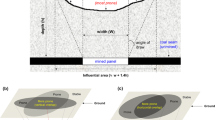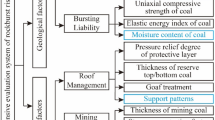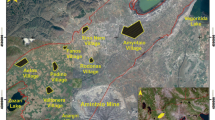Abstract
From the viewpoint of safety in underground coal mining, the most suitable mining panel is the one with minimum geological structures, the right machinery, and equipment selection, trained employee, and proficient stope management. Since the ground parameters are uncontrollable and inherent uncertainties exist, a high percent of risk will usually accompany the underground coal mining activities. The main purpose of this study is to present a geological–geotechnical risk assessment model for identification of high risk-prone areas in underground coal mines using an integrated GIS-geostatistics system. Tabas as the first mechanized and largest underground coal mine in Iran was selected as a case study in this study. Gas content of coal seam, Coal Mine Roof Rating (CMRR), initial in situ stress state, fault throw, and orientation were selected as hazard/risk factors. For estimating the amount of coal seam gas content, CMRR and initial in situ stress in unsampled areas and providing the prediction maps, geostatistics module in ArcGIS was used. Rock engineering system–interaction matrix method was used for attribute weight assignment. Next, the attribute layers were weighted, rated, and overlaid to create a final map of geohazards risk. The analysis results of final risk map indicate that about 45% of under study area is prone to high to very high geohazards risk. Comparison of the results with experiences obtained during the early part of the mine and mined-out panels showed generally good agreement with promising ideas. This highlights the potential application of the GIS-based approach for hazards detection and geohazards risk assessment in underground coal mines.



Reproduced with permission from Najafi et al. 2011















Similar content being viewed by others
References
Abdel Salam ME (1995) Contractual sharing of risks in underground construction: ITA views. Tunn Undergr Space Technol 10:433–437
Ataei M, Khalokakaei R, Hossieni M (2009) Determination of coal mine mechanization using fuzzy logic. Min Sci Technol 19(2):149–154
Bieniawski ZT (1989) Engineering rock mass classifications. Wiley, New York
Cai Y, Liu D, Yao Y, Li J, Qiu Y (2011) Geological controls on prediction of coalbed methane of no. 3 coal seam in Southern Qinshui Basin, North China. Int J Coal Geol 88:101–112
Caillé A, Al-Moneef M, de Castro FB, Bundgaard-Jensen A, Fall A, de Medeiros NF, Jain CP, Kim YD, Nadeau MJ, Testa C, Teyssen J (2007) 2007 Survey of Energy Resources. World Energy Council
Coleman P, Kerkering J (2007) Measuring mining safety with injury statistics: lost workdays as indicators of risk. J Saf Res 38:523–533
Duzgun HSB, Einstein HH (2004) Assessment and management of roof fall risks in underground coal mines. Saf Sci 24:23–41
Einstein HH (1996) Risk and risk analysis in rock engineering. Tunnel Undergr Space Technol 11:141–155
Geng F, Saleh JH (2015) Challenging the emerging narrative: critical examination of coalmining safety in China, and recommendations for tackling mining hazards. Saf Sci 75:36–48
Ghasemi E, Ataei M, Shahriar K, Sereshki F, Jalali SME, Ramazanzadeh A (2012) Assessment of roof fall risk during retreat mining in room and pillar coal mines. Int J Rock Mech Min Sci 54:80–89
Goovaerts P (1997) Geostatistics for natural resources evaluation. Oxford University Press, Oxford
Guglielmetti V, GrassoP Mahtab A, Xu S (eds) (2008) Mechanized tunnelling in urban areas: design methodology and construction control. Taylor and Francis Group, London
Hammah RE, Curran JH (2006) Geostatistics in geotechnical engineering: Fad or empowering? GeoCongress 2006:1–5
Harris J, Kirsch P, Shi M, Li J, Gagrani A, Krishna ESA, Tabish A, Arora A, Kothandaraman K, Cliff D (2014) Comparative analysis of coal fatalities in Australia, South Africa, India, China and USA, 2006–2010. In: 14th Coal Operators’ Conference, Australia, pp 399–407
Hubbert MK (1976) Exponential growth as a transient phenomenon in Human history. In: World Wildlife fund’s conference, the Fragile Earth: towards strategies for survival, San Francisco
Hudson JA (1992) Rock engineering systems: theory and practice. Ellis Horwood Ltd., Chi Chester
Journel AG, Huijbregts CJ (1978) Mining geostatistics. Academic Press, London
Kaminska IA, Oldak A, Turski WA (2004) Geographical information system (GIS) as a tool for monitoring and analysing pesticide pollution and its impact on public health. Ann Agric Environ Med 11(2):181–184
Kevin J, VerHoef JM, Krivoruchko K, Lucas N (2003) Using ArcGIS geostatistical analyst. Environ. Syst. Res. Inst, Redlands
Khanzode VV, Maiti J, Ray PK (2011) A methodology for evaluation and monitoring of recurring hazards in underground coal mining. Saf Sci 49:1172–1179
Laherrere J (2006) Oil and gas: what future? World 1(292, 549):534
Lu Y, Li X (2011) A study on a new hazard detecting and controlling method: the case of coal mining companies in China. Saf Sci 49(2):279–285
Mahdevari S, Shahriar K, Esfahanipour A (2014) Human health and safety risks management in underground coal mines using fuzzy TOPSIS. Sci Total Environ 488–489:85–99
Margaret A, Carignan J (1997) Géostatistiquelinéaire: application au domaineminier. Les Presses de l’Ecole des Mines, Paris
Mark C, Molinda GM (2005) The coal mine roof rating (CMRR)—a decade of experience. Int J Coal Geol 64(1–2):85–103
Matheron G (1965) La théorie des variables régionaliséesetses applications. Masson etCieÉditeurs, Paris
Mine Safety and Health Administration (MSHA) (2015) Injury trends in mining. www.msha.gov/MSHAINFO/FactSheets/MSHAFCT2.HTM. Accessed Sept 2015
Mohr SH, Evans GM (2009) Forecasting coal production until 2100. Fuel 88(11):2059–2067
Najafi M, Jalali SE, YarahmadiBafghi AR, Sereshki F (2011) Prediction of the confidence interval for stability analysis of chain pillars in coal mines. Saf Sci 49(5):651–657
Palei SK, Das SK (2009) Logistic regression model for prediction of roof fall risks in bord and pillar workings in coal mines: an approach. Saf Sci 47(1):88–96
Prakash A, Vekerdy Z (2004) Design and implementation of a dedicated prototype GIS for coal fire investigations in North China. Int J Coal Geol 59(1–2):107–119
Razani M, Yazdani-Chamzini A, Haji Yakhchali S (2013) A novel fuzzy inference system for predicting roof fall rate in underground coal mines. Saf Sci 55:26–33
Rozos D, Bathrellos G, Skilodimou H (2011) Comparison of the implementation of rock engineering system (RES) and analytic hierarchy process (AHP) methods, based on landslide susceptibility maps, compiled in GIS environment. A case study from the Eastern Achaia County of Peloponnesus, Greece. Environ Earth Sci 63(1):49–63
Saffari A, Sereshki F, Ataei M, Ghanbari K (2013) Applying rock engineering systems (RES) approach to evaluate and classify the coal spontaneous combustion potential in eastern alborz coal mines. Int J Min Geo-Eng 47(2):115–127
Şalap S, Karslıoğlu MO, Demirel N (2009) Development of a GIS-based monitoring and management system for underground coal mining safety. Int J Coal Geol 80(2):105–112
Salmon G, Cattanach D, Hartford D (1997) Risk management at Whleach dam. Civ Eng ASCE 67(2):39–41
Sari M, Duzgun HSB, Karpuz C, Selcuk AS (2004) Accident analysis of two Turkish underground coal mines. Saf Sci 42:675–690
Sari M, Selcuk AS, Karpuz C, Duzgun HSB (2009) Stochastic modeling of accident risks associated with an underground coal mine in Turkey. Saf Sci 47(1):78–87
Skochinsky A, Komarov V (1969) Mine ventilation. Mir publishers, Moscow
Sturk R, Olsson L, Johansson J (1996) Risk and decision analysis for large underground projects, as applied to the Stockholm ring road tunnels. Tunn Undergr Space Technol 11(2):157–164
Vaziri V, Khademi Hamidi J, Sayadi AR (2015) Estimation of coal gas content using geostatistical methods in GIS environment: a case study from Tabas coal mine. In: Proceedings of the 24th international mining congress of Turkey IMCET, pp 1007–1015
Wang Y, Yang W, Li M, Liu X (2012) Risk assessment of floor water inrush in coal mines based on secondary fuzzy comprehensive evaluation. Int J Rock Mech Min Sci 52:50–55
Wang L, Wang Y, Cao Q, Li X, Li J, Wu X (2014) A framework for human error risk analysis of coal mine emergency evacuation in China. J Loss Prev Process Ind 30:113–123
Whitman RV (2000) Organizing and evaluating uncertainty in geotechnical engineering. J Geotech Geoenviron Eng 126(7):583–593
World Coal Association (2014a) Coal facts, 2014. http://www.worldcoal.org/resources/coal-statistics/. Accessed Sept 2014
World Coal Association (2014b) WCA commitment to safety. http://www.worldcoal.org/coal-society/safety-issues/. Accessed July 2014
Wu JJ, Liu XC (2011) Risk assessment of underground coal fire development at regional scale. Int J Coal Geol 86(1):87–94
Yao Y, Liu D, Tang D, Tang S, Che Y, Huang W (2009) Preliminary evaluation of the coalbed methane production potential and its geological controls in the Weibei Coalfield, Southeastern Ordos Basin, China. Int J Coal Geol 78(1):1–15
Yenilmez F, Kuter N, Emil MK, Aksoy A (2011) Evaluation of pollution levels at an abandoned coal mine site in Turkey with the aid of GIS. Int J Coal Geol 86(1):12–19
Yunxiao F, Ming L (2012) Design of hazards list based on hazard components for Chinese coalmine. Procedia Eng 45:264–270
Zare Naghadehi M, Jimenez R, KhaloKakaie R, Jalali SME (2011) A probabilistic systems methodology to analyze the importance of factors affecting the stability of rock slopes. Eng Geol 118(3–4):82–92
Zare Naghadehi M, Jimenez R, KhaloKakaie R, Jalali SME (2013) A new open-pit mine slope instability index defined using the improved rock engineering systems approach. Int J Rock Mech Min Sci 61:1–14
Zhang M, Shimada H, Sasaoka T, Matsui K, Dou L (2013) Seismic energy distribution and hazard assessment in underground coal mines using statistical energy analysis. Int J Rock Mech Min Sci 64:192–200
Zhu ZW, Shi YK, Qin GP, Bian PY (2011) Research on the occupational hazards risk assessment in coal mine based on the hazard theory. Procedia Eng 26:2157–2164
Acknowledgements
The authors are deeply grateful to the manager and employees of Tabas Coal Mine Complex, especially engineers in technical office, division of education and research for their kind help and sharing their experiences from the data gathering efforts during the field studies.
Author information
Authors and Affiliations
Corresponding author
Rights and permissions
About this article
Cite this article
Vaziri, V., Khademi Hamidi, J. & Sayadi, A.R. An integrated GIS-based approach for geohazards risk assessment in coal mines. Environ Earth Sci 77, 29 (2018). https://doi.org/10.1007/s12665-017-7198-0
Received:
Accepted:
Published:
DOI: https://doi.org/10.1007/s12665-017-7198-0




